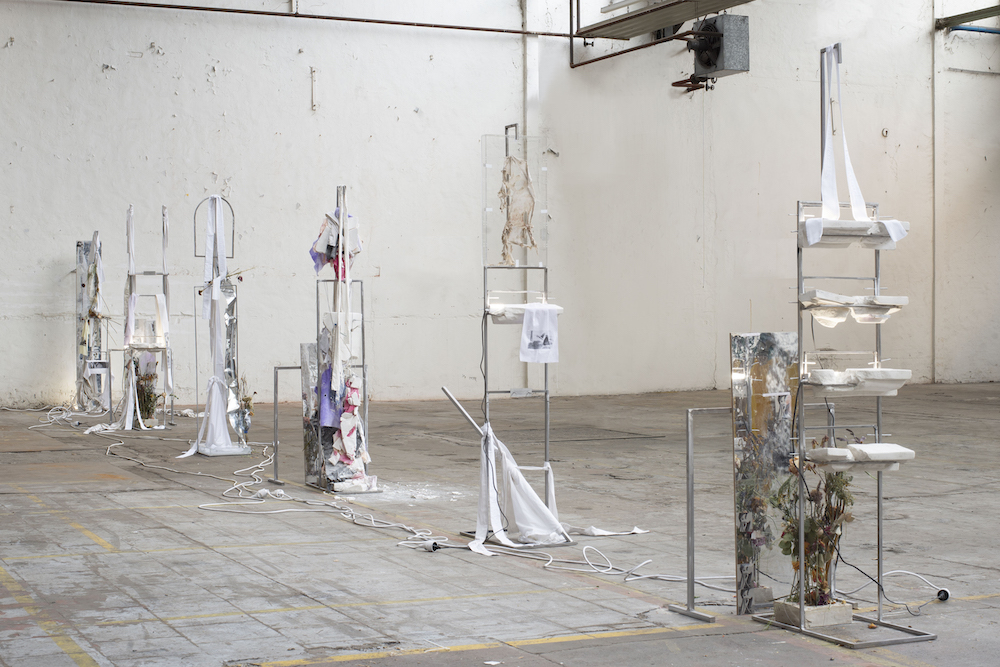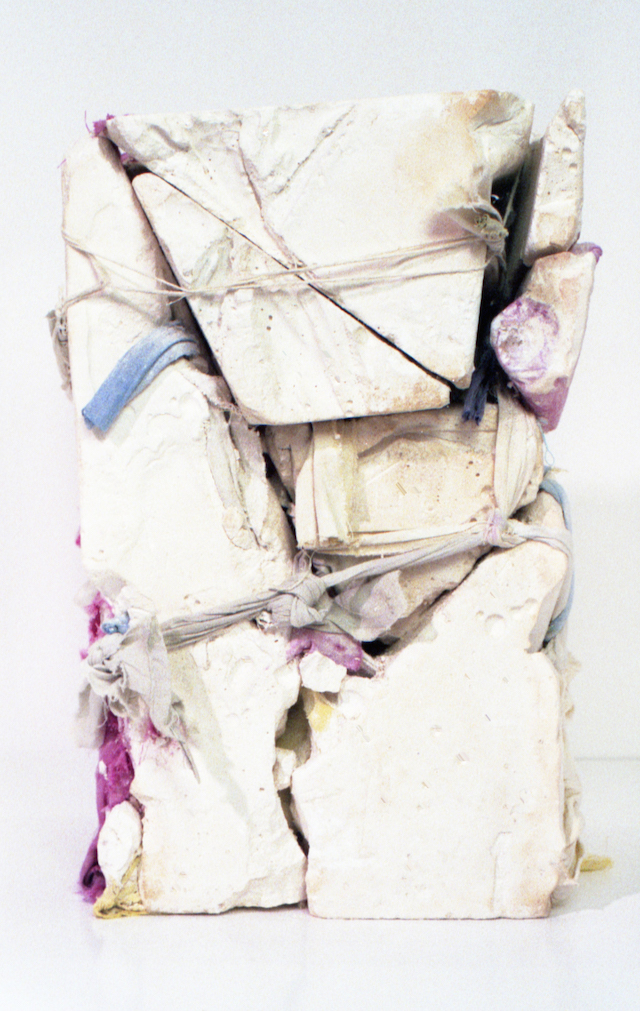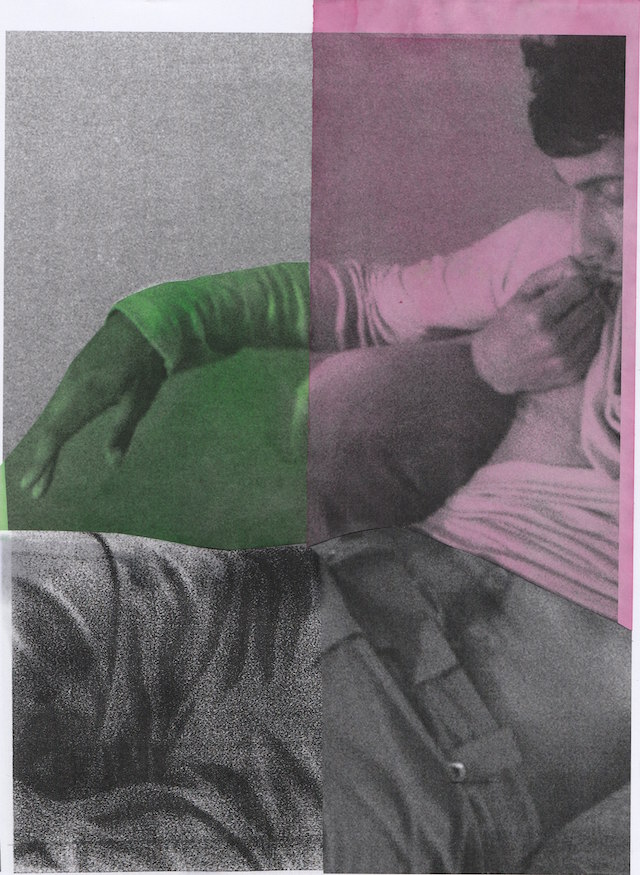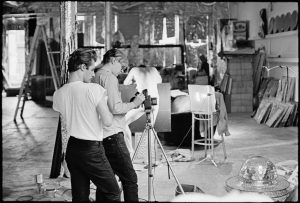In conversation with artist Pieter Eliëns

Reviewing the selected work of Pieter Eliëns I was struck by the pieces he had labelled ‘autonomous’, i.e work he had undertaken himself, not been commissioned for. Each and every artwork was indeed autonomous; free, self-determining and – from the ancient Greek autonomos – possessing ‘its own laws’. Or, as he explains in our interview down below: “I very much enjoy this idea that it is not only me making the work, but also the work becoming something out of itself, as having a mind of its own.”
Many of his forms share similar codes with our own human cycles of movement and decay; a rich array of materials are bound, suspended, hung, fused, stretched. Like all great sculptural artwork there is movement, tension and animation. Consider Eliëns’ Insight, Inside – what looks like sea shingle and undulating waves climbs a wall, disrupting the traditional white cube space – or Falling, Failing, that calls to mind both the graceful play of school gymnasiums and surrender flags, white fabric active yet limp without a breeze. Despite structures being in a state of flux and ordered disarray, at the heart of much of his work there is a carefully considered tenderness and longing. Eliëns’ totemic and monumental (in both senses of the word) Elegy installation at Expo Antwerp, Blikfabriek, was comprised of six shrine-like stands in a straight line. The tall structures echoed the crumpled flowers, tied scarves and pictures of passed loved ones we sometimes encounter in public spaces, that, between the creator and the absent, become a private, emotionally charged zone of remembrance.
Currently based in London as artist-in-residence at Picton Studios – supported and in collaboration with Selfridges – the Netherlands-born creative has lived and worked in Amsterdam, Paris and Antwerp. Port caught up with him to discuss the inspiration behind his practice, reflecting human fragility, and the power of the handmade in the age of machines.

Where do you draw inspiration from?
Mostly I develop thoughts and ideas for work out of observations from the street. Really looking at your surroundings can be very fascinating. The ‘urban environment’ has so many different unexpected scenes and they are to be found almost everywhere. There are so many stories, timelines and emotions intersected and entangled in our daily surroundings that simply by being attentive to the world around you can develop new thoughts. Many people have these feelings when being in nature instead of the city landscape as their direct environment, but the urban landscape activates much more thoughts for me.
What challenges and pleasures do the different materials you work with present? I know your selection is diverse and fabric reoccurs, in part because of its strength or ability to convey emotion…
As I do not have one specific material that I work with, it is always a bit of a new adventure and exploration of possibilities. I am honestly quite clumsy when working in the studio, which always results in accidents and unpredicted outcomes. This is what keeps me going the most; when a material or a process leads you to something that you did not expect. I experience this as the work having the ability to ‘open you up’.
I like to work intuitively and allow mistakes to happen. I very much enjoy this idea that it is not only me making the work, but also the work becoming something out of itself, as having a mind of its own. I perhaps like to believe that every material carries a certain will of its own. Sometimes I can work on my own, but still collaborate together with the material and have an exchange and guidance because of its possible limits and qualities.
There is always a bit of a struggle with exact dimensions, numbers, calculations or precise works. A very precise or totally organised mind-set and attitude does not come natural to me, however, quite a lot of my ideas, strangely enough, are partly quite precise. As an opponent in the process I somehow search and long for those materials that can be worked with in more intuitive ways and with a less exact mind-set.
Fabric is indeed a material I am very drawn to and that keeps coming back into my work in one way or another. I like the flexibility of the material. It can have many different appearances simply by using different, honest and direct ways of treating it. I am deeply interested in how to convey an emotion into a piece of fabric. It is an exploration into what fabric can communicate when it has been handled with different approaches. What does it say when its stretched, folded, ripped, knotted, tied around, hung, in movement or boxed in and closed off? I am interested in when fabric becomes a ‘bodily state’, with which I mean it becomes a body, stored with emotion, similar to our own bodies.

In what ways does your practice and the things you create work against or in contrast to “the overload of things made by machines”?
For me it is important to see the ‘hand’, the gesture in my work. Quite literally I like to see how things are made. I like when traces of the process leave their marks onto the material. It is very unlikely I will 3D print something. Its mechanical process does not interest me. I like when the connection with the hands is as close as possible. Interventions with a machine can of course be interesting but for me only up to a point; it is the hands that I like to be closest to the work, if possible.
Honestly there is so much that we surround ourselves with that is produced by machines that I almost think our senses have gotten flattened. I think a lot of surfaces are disappearing. Our ability to see and know how something is made disappears. I am quite frightened that in the future we only will end up with machines and products that we cannot comprehend, that we cannot repair ourselves and that we only partly understand. We need enormous teams of people to understand how one single machine works. More and more complex systems and machines surround us but we really understand less and less about how they actually work.
To put it quite simply I think that objects, which are made by hand, are able to connect with us, since it’s human hands that have made them. There is a mutual understanding and therefore an exchange; they literally relate to each other. I guess it has to do with this idea that these kinds of objects make me able to understand the world, rather than get lost in it. Within my work I look for this same direct connection to materiality and construction as well. I don’t want to make something that works with techniques I don’t really comprehend. When I see how something is made, I feel faced with a certain honesty in the work.

I know you are also interested in decay, collapse, things in flux – why do you find fragile sculptures more interesting than very fixed or solid works?
We as human are fragile. We are neither solid nor ‘fixed’ ourselves. We have to live with our emotions and with those of others; we are daily faced with death, decay and environments that are in flux. I think that when a sculptural work shows its vulnerability, it is able to make a connection with our vulnerable parts too. They connect because they share a similarity and through this we can exchange something.
I am not so interested in a solid shape. I like this idea that my work consists out of different materials that could be reused in other works as well. Partly this has to do with me having an environmental dilemma of using material and and not contributing too much to our ever-growing mass of waste. Also, when you are not constantly selling your work you have to think about how you archive or store them, or whether your store them at all. Therefore, I also like the works to be as least solid as possible so partly they do not need to be stored, as they will automatically have the ability to turn into something else.

I loved your Elegy installation at Blikfabriek, and found it moving even though I was only viewing it on my computer screen. It put me in mind of the flowers left in public spaces, a space not normally afforded emotional capacity – could you perhaps expand on your thinking behind it?
I was observing different ways in which people could emotionally charge a space. We are all familiar with spaces in the urban landscape where people mourn their losses. We all have seen a bouquet of flowers hanging on a tree or pole, some pictures showing someone that passed away or a handwritten text or an engraved plate on a park bench to commemorate someone.
I am fascinated by how, with small means, a place can be charged with meaning by leaving something behind in one way or another. I think of them as beautiful DIY memorials. I think it is important to be aware of these places, to notice them and give them attention. Being attentive to these places makes us human, I think, because it touches upon our sensibility. In addition, I was also thinking about shrines, about monuments, about preservation, about connection and genealogy.
Could you talk a bit about your residency at Picton Studios, how you’re supported and what sort of work you’re hoping to create there? Is it a private space where things can go wrong?
The department store Selfridges hosts an artist-in-residence in an apartment on Picton Place in Mayfair. For a period of 6 months the artist is given this place to live and to work in a separate studio space within the same apartment. You are able to meet some people of the creative department of Selfridges and can discuss the possibility to collaborate with them. There is no fixed outcome expected, but Selfridges as a host is interested in giving the artist the opportunity to make a work or window display.
The studio is quite a tidy space and my usual work requires a space that can deal with rough, messy works as well. But I am interested to see what this difference in studio space also brings to my work. My work is more 2D paper based at the moment. For example, I have started some movement recording in the studio, which I will work out in pieces that are more two-dimensional. I am looking forward to see if I could develop some new body of work specifically for some of the windows for Selfridges.

In terms of other upcoming projects, what do you have planned for the group show at the Musée d’Art Moderne Grand-Duc Jean. Is there a brief or theme you’re responding too?
This group show is part of a research project titled ‘Forms of Life’ that is collaboration between the Mudam Luxenbourg, The Royal Academy of Fine Arts Antwerp and the Luxenbourg Pavillion at the Venice Biennale 2022. In this research project we focus on the relation between different forms of life, both living and non-living. There are many ways to look at this topic but I think essentially it is about how we can acknowledge forms of life outside ourselves, outside the human construct.
The research we do aims to generate more awareness of other forms of life and shows us that we are part of the earth instead of its ruler. In essence we try to see and explore beyond a human point of view into an approach that is aware of our entanglement with other life forms. Every artist that participates in the group show is part of this research group, but we respond to this topic individually with our own backgrounds and artistic practices.
There were many different great seminars and lectures, among others with professor of social anthropology, Tim Ingold. Ingold is one of these thinkers that can make you see and understand the world through such different perspectives. There is a necessity to urgently understand how to inhabit our home differently. The way in which we have lived on earth has damaged our surroundings so intensely that we are experiencing the devastating effects of our global misbehaviour. Ingold let us look at the world anew to establish a relationship to it that could be healthier for earth and all its species.

I’d like to touch on the photographic personal project you’re working on at the moment. In our current climate, the act of two males holding and supporting one another seems like a powerful political act of care and love, what drew you to this subject matter and what questions would you like to ask?
In many recent works I thought a lot about this notion of support. How can I make support between materials visible and use it as a metaphor that could potentially speak to us? I want to explore what happens when I quite literally depict ‘support’ between two human beings. By making support visible I am automatically thinking about the scenario of ‘non support’, the collapse. These pictures are also an investigation in how much collapse I would like to show within this support.
In your writing about it, I was struck by your phrasing of the ‘action of taking care’, because care isn’t passive in any relationship, it requires conscious action, and care is often physical, requires tactile contact…
I do find that living ones life, perhaps especially in big cities, there is so much lack of care, lack of attention, lack of human connection. Literally everyone is linked to their screens, in public and at home. I find it very worrying that people forget what it is to simply notice each other. If you hop on any underground system in big capitals the majority of people are locked to their phones and losing their ability to grow sympathy towards the world around them. Adult people playing Candy Crush for hours on their phones. How can this be nourishing? To only connect with screens means to disconnect from important facets of life behind those screens. The anxiety that this gives me is enormous. It signifies that we are mutating into a less good version of what we are supposed to be. My banner with ‘Please let us care’ was hung up around these reflections. People can interpret this in any way they please, since at this moment we need more ‘care’ in whatever way is possible.




